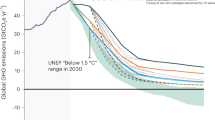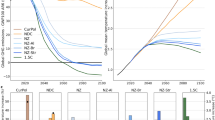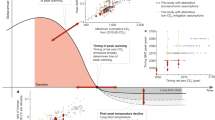Abstract
Over the last five years prior to the Glasgow Climate Pact1, 154 Parties have submitted new or updated 2030 mitigation goals in their nationally determined contributions and 76 have put forward longer-term pledges. Quantifications of the pledges before the 2021 United Nations Climate Change Conference (COP26) suggested a less than 50 per cent chance of keeping warming below 2 degrees Celsius2,3,4,5. Here we show that warming can be kept just below 2 degrees Celsius if all conditional and unconditional pledges are implemented in full and on time. Peak warming could be limited to 1.9–2.0 degrees Celsius (5%–95% range 1.4–2.8 °C) in the full implementation case—building on a probabilistic characterization of Earth system uncertainties in line with the Working Group I contribution to the Sixth Assessment Report6 of the Intergovernmental Panel on Climate Change (IPCC). We retrospectively project twenty-first-century warming to show how the aggregate level of ambition changed from 2015 to 2021. Our results rely on the extrapolation of time-limited targets beyond 2030 or 2050, characteristics of the IPCC 1.5 °C Special Report (SR1.5) scenario database7 and the full implementation of pledges. More pessimistic assumptions on these factors would lead to higher temperature projections. A second, independent emissions modelling framework projected peak warming of 1.8 degrees Celsius, supporting the finding that realized pledges could limit warming to just below 2 degrees Celsius. Limiting warming not only to ‘just below’ but to ‘well below’ 2 degrees Celsius or 1.5 degrees Celsius urgently requires policies and actions to bring about steep emission reductions this decade, aligned with mid-century global net-zero CO2 emissions.
This is a preview of subscription content, access via your institution
Access options
Access Nature and 54 other Nature Portfolio journals
Get Nature+, our best-value online-access subscription
$29.99 / 30 days
cancel any time
Subscribe to this journal
Receive 51 print issues and online access
$199.00 per year
only $3.90 per issue
Buy this article
- Purchase on Springer Link
- Instant access to full article PDF
Prices may be subject to local taxes which are calculated during checkout





Similar content being viewed by others
Data availability
The data archive for this study is available at https://doi.org/10.5281/zenodo.5886866, which includes the scenario data, temperature outcomes and supplementary tables48. Country-level emission quantifications of NDCs and LT-LEDs (the ‘NDC Factsheets’)49 are available at https://doi.org/10.5281/zenodo.5768669 and are also interactively available at https://climate-resource.com/tools/ndcs. The source data PRIMAP-hist CR is provided at https://doi.org/10.5281/zenodo.5494497. Source data are provided with this paper.
Code availability
The analysis code used in this study is provided by Silicone (version 1.2.1) for the infilling, available at https://github.com/GranthamImperial/silicone, and by the Anaeris package (version 0.2.0+41.g6ddf6e5) for the harmonization, available at https://github.com/iiasa/aneris. The climate model MAGICC7.5 is in the process of becoming open source (re-factoring ongoing), the model is available as an interactive mode at http://live.magicc.org. The source code for extrapolating and infilling of the NDC scenarios are available at https://gitlab.com/climate-resource/ndc-realisations-2021.
References
UNFCCC. Glasgow Climate Pact https://unfccc.int/documents/310475 (United Nations Framework Convention on Climate Change, 2021).
Ou, Y. et al. Can updated climate pledges limit warming well below 2 °C? Science 374, 693–695 (2021).
UNEP. Emissions Gap Report 2021: The Heat is On – A World of Climate Promises Not Yet Delivered https://www.unep.org/resources/emissions-gap-report-2021 (United Nations Environment Programme, 2021).
IEA. World Energy Outlook 2021 https://www.iea.org/reports/world-energy-outlook-2021 (International Energy Agency, 2021).
Rogelj, J. et al. Paris Agreement climate proposals need a boost to keep warming well below 2 °C. Nature 534, 631–639 (2016).
IPCC. Climate Change 2021: The Physical Science Basis. Contribution of Working Group I to the Sixth Assessment Report of the Intergovernmental Panel on Climate Change (Cambridge Univ. Press, 2021).
Huppmann, D., Rogelj, J., Kriegler, E., Krey, V. & Riahi, K. A new scenario resource for integrated 1.5 °C research. Nat. Clim. Change 8, 1027–1030 (2018).
Masson-Delmotte, V. et al. Global Warming of 1.5 °C. An IPCC Special Report on the Impacts of Global Warming of 1.5 °C Above Pre-Industrial Levels and Related Global Greenhouse Gas Emission Pathways, in the Context of Strengthening the Global Response to the Threat of Climate Change, Sustainable Development, and Efforts to Eradicate Poverty https://www.ipcc.ch/sr15 (IPCC, 2018).
Stott, P. A. et al. Attribution of extreme weather and climate‐related events. Wiley Interdiscip. Rev. Clim. Change 7, 23–41 (2016).
IRENA. Renewable Power Generation Costs in 2020 (International Renewable Energy Agency, 2021).
Hausfather, Z. & Peters, G. P. Emissions – the ‘business as usual’story is misleading. Nature 577, 618–620 (2020).
UNFCCC. The Paris Agreement (UNFCCC, 2015); https://unfccc.int/process-and-meetings/the-paris-agreement/the-paris-agreement
UNFCCC. Common Time Frames for Nationally Determined Contributions Referred to in Article 4, Paragraph 10, of the Paris Agreement https://unfccc.int/sites/default/files/resource/cma3_auv_3b_CTF.pdf (UNFCCC, 2021).
Modi, N. National Statement by Prime Minister Shri Narendra Modi at COP26 Summit in Glasgow https://www.mea.gov.in/Speeches-Statements.htm?dtl/34466/National+Statement+by+Prime+Minister+Shri+Narendra+Modi+at+COP26+Summit+in+Glasgow (Ministry of External Affairs, Government of India, 2 November 2021).
IMO. Adoption of the Initial IMO Strategy on Reduction of GHG Emissions from Ships and Existing IMO Activity Related to Reducing GHG Emissions in the Shipping Sector https://unfccc.int/sites/default/files/resource/250_IMO%20submission_Talanoa%20Dialogue_April%202018.pdf (International Maritime Organization, 2018).
ICAO. Resolution A40-18: Consolidated Statement of Continuing ICAO Policies and Practices Related to Environmental Protection – Climate Change https://www.icao.int/environmental-protection/Documents/Assembly/Resolution_A40-18_Climate_Change.pdf (International Civil Aviation Organization, 2019).
Zimm, C. & Nakicenovic, N. What are the implications of the Paris Agreement for inequality? Clim. Policy 20, 458–467 (2020).
Günther, A., Gütschow, J. & Jeffery, M. L. NDCmitiQ v1.0.0: a tool to quantify and analyse greenhouse gas mitigation targets. Geosci. Model Dev. 14, 5695–5730 (2021).
UNEP. Addendum to the Emissions Gap Report 2021 https://wedocs.unep.org/bitstream/handle/20.500.11822/37350/AddEGR21.pdf (United Nations Environment Programme, 2021).
Climate Analytics & NewClimate. Climate Action Tracker. Warming Projections Global Update: November 2021 https://climateactiontracker.org/documents/997/CAT_2021-11-09_Briefing_Global-Update_Glasgow2030CredibilityGap.pdf (Climate Analytics, NewClimate, 2021).
Gütschow, J., Jeffery, M. L., Schaeffer, M. & Hare, B. Extending near-term emissions scenarios to assess warming implications of Paris Agreement NDCs. Earth’s Future 6, 1242–1259 (2018).
Jeffery, M. L., Gütschow, J., Rocha, M. R. & Gieseke, R. Measuring success: improving assessments of aggregate greenhouse gas emissions reduction goals. Earth’s Future 6, 1260–1274 (2018).
Sognnaes, I. et al. A multi-model analysis of long-term emissions and warming implications of current mitigation efforts. Nat. Clim. Change 11, 1055–1062 (2021).
Meinshausen, M. et al. Multi-gas emission pathways to meet climate targets. Clim. Change 75, 151–194 (2006).
Lamboll, R. D., Nicholls, Z. R. J., Kikstra, J. S., Meinshausen, M. & Rogelj, J. Silicone v1.0.0: an open-source Python package for inferring missing emissions data for climate change research. Geosci. Model Dev. 13, 5259–5275 (2020).
Friedlingstein, P. et al. Global carbon budget 2021. Preprint at Earth System Science Data https://doi.org/10.5194/essd-2021-386 (2021).
UNFCCC. Nationally Determined Contributions Under the Paris Agreement – Revised Synthesis Report by the Secretariat. Report no. FCCC/PA/CMA/2021/8/Rev.1, 42 https://unfccc.int/process-and-meetings/the-paris-agreement/nationally-determined-contributions-ndcs/nationally-determined-contributions-ndcs/ndc-synthesis-report (UNFCCC, 2021).
Forster, P. et al. in Climate Change 2021: The Physical Science Basis. Contribution of Working Group I to the Sixth Assessment Report of the Intergovernmental Panel on Climate Change (eds Masson-Delmotte, V. et al.) Ch. 7 (Cambridge Univ. Press, 2021).
Collins, M. et al. in Climate Change 2013: The Physical Science Basis. Contribution of Working Group I to the Fifth Assessment Report of the Intergovernmental Panel on Climate Change (eds Stocker, T. F. et al.) 1029–1136 (Cambridge Univ. Press, 2013).
Rogelj, J. et al. A new scenario logic for the Paris Agreement long-term temperature goal. Nature 573, 357–363 (2019).
Riahi, K. et al. Cost and attainability of meeting stringent climate targets without overshoot. Nat. Clim. Change 11, 1063–1069 (2021).
European Commission. Launch by United States, the European Union, and partners of the Global Methane Pledge to keep 1.5C within reach. European Commission Press Corner https://ec.europa.eu/commission/presscorner/detail/en/statement_21_5766 (2 November 2021).
IEA. World Energy Outlook 2021: Technical Note on the Emissions and Temperature Implications of COP26 Pledges https://iea.blob.core.windows.net/assets/aa17bd09-2ad0-4d0a-b5aa-ee418900c4af/Theimpactsofnewemissionspledgesonlongtermtemperatures.pdf (International Energy Agency, 2021).
Gütschow, J., Günther, A. & Pflüger, M. The PRIMAP-hist national historical emissions time series (1750–2019) v2.3.1. Zenodo https://doi.org/10.5281/zenodo.5494497 (2021).
IEA. World Energy Outlook 2020 https://www.iea.org/reports/world-energy-outlook-2020 (International Energy Agency, 2020).
World Bank. World Bank Country and Lending Groups - Country Classification by Income (World Bank, 2021); https://datahelpdesk.worldbank.org/knowledgebase/articles/906519-world-bank-country-and-lending-groups (11 November 2021)
Gütschow, J. et al. The PRIMAP-hist national historical emissions time series. Earth Syst. Sci. Data 8, 571–603 (2016).
Houghton, J. T. et al. (eds) Revised 1996 Guidelines for National Greenhouse Gas Inventories https://www.ipcc-nggip.iges.or.jp/public/gl/invs1.html (IPCC, 1996).
Gütschow, J., Jeffery, M. L., Günther, A. & Meinshausen, M. Country-resolved combined emission and socio-economic pathways based on the Representative Concentration Pathway (RCP) and Shared Socio-Economic Pathway (SSP) scenarios. Earth Syst. Sci. Data 13, 1005–1040 (2021).
King, L. C. & van den Bergh, J. C. J. M. Potential carbon leakage under the Paris Agreement. Clim. Change 165, 52 (2021).
Gidden, M. J. et al. A methodology and implementation of automated emissions harmonization for use in Integrated Assessment Models. Environ. Modelling Softw. 105, 187–200 (2018).
Grassi, G. et al. Critical adjustment of land mitigation pathways for assessing countries’ climate progress. Nat. Clim. Change 11, 425–434 (2021).
Meinshausen, M., Raper, S. C. B. & Wigley, T. M. L. Emulating coupled atmosphere–ocean and carbon cycle models with a simpler model, MAGICC6 – Part I – model description and calibration. Atmos. Chem. Phys. 11, 1417–1456 (2011).
Nicholls, Z. et al. Reduced Complexity Model Intercomparison Project Phase 2: synthesizing Earth system knowledge for probabilistic climate projections. Earth’s Future 9, e2020EF001900 (2021).
UN. United Nations World Population Prospects 2019, Online Edition, Rev. 1 https://population.un.org/wpp/Download/Standard/Population (United Nations, 2019).
Gössling, S. & Humpe, A. The global scale, distribution and growth of aviation: implications for climate change. Global Environ. Change 65, 102194 (2020).
Gulev, S. K. et al. in Climate Change 2021: The Physical Science Basis. Contribution of Working Group I to the Sixth Assessment Report of the Intergovernmental Panel on Climate Change (eds V. Masson-Delmotte et al.) Ch. 2 (Cambridge Univ. Press, 2021).
Meinshausen, M. et al. Data for study “Realisation of Paris Agreement climate pledges may limit warming just below 2 °C”. Zenodo https://doi.org/10.5281/zenodo.5886866 (2022).
Meinshausen, M., Lewis, J., Nicholls, Z. & Guetschow, J. NDC factsheets. Zenodo https://doi.org/10.5281/zenodo.5768669 (2021).
Climate Action Tracker. Temperatures https://climateactiontracker.org/global/temperatures/ (2021).
Acknowledgements
We acknowledge discussions and collaborations with several colleagues of the UNEP Gap report team and the IAM modellers contributing to the SR1.5 and ENGAGE scenario databases. M.M. is the recipient of an Australian Research Council (ARC) Future Fellowship (grant number FT130100809). C.M., L.C. and B.H. state that the views expressed in this article are in the author’s personal capacity and do not necessarily reflect the views of the United Nations, United Nations Climate Change or the International Energy Agency.
Author information
Authors and Affiliations
Contributions
All authors contributed to writing the study. M.M. designed the study and quantified the NDCs for the bottom-up NDC analysis; J.L. performed the global harmonization, climate model runs and analysis; C.M. and L.C. provided the analysis of net-zero emission targets and the IEA scenarios; Z.N. provided the code base for the probabilistic climate model analysis and analysis of the ENGAGE database; and J.G. provided the PRIMAP-hist data.
Corresponding author
Ethics declarations
Competing interests
The authors declare no competing interests.
Peer review
Peer review information
Nature thanks Kalyn Dorheim, Zeke Hausfather and the other, anonymous, reviewer(s) for their contribution to the peer review of this work.
Additional information
Publisher’s note Springer Nature remains neutral with regard to jurisdictional claims in published maps and institutional affiliations.
Extended data figures and tables
Extended Data Fig. 1 CO2 emissions for various scenarios.
Extended Data Fig. 2 Sensitivity test of database temperature projections in the ENGAGE database31.
The 25 closest scenarios in terms of their 2050 GHG emissions (GWP-100 AR6, excluding LULUCF) to this study’s scenario A (thick blue line, Extended Data Table 2) are selected (thin coloured lines). For the respective emission level around 30 GtCO2e by 2050, more of the selected ENGAGE scenarios suggest lower post-2050 GHG emission levels than our scenario A, which had been extrapolated using an equal-quantile-walk approach on the basis of the SR1.5 scenario database7.
Rights and permissions
About this article
Cite this article
Meinshausen, M., Lewis, J., McGlade, C. et al. Realization of Paris Agreement pledges may limit warming just below 2 °C. Nature 604, 304–309 (2022). https://doi.org/10.1038/s41586-022-04553-z
Received:
Accepted:
Published:
Issue Date:
DOI: https://doi.org/10.1038/s41586-022-04553-z
This article is cited by
-
Systemwide energy return on investment in a sustainable transition towards net zero power systems
Nature Communications (2024)
-
Paris targets within reach by aligning, broadening and strengthening net-zero pledges
Communications Earth & Environment (2024)
-
Antarctic meteorites threatened by climate warming
Nature Climate Change (2024)
-
A survey of interventions to actively conserve the frozen North
Climatic Change (2024)
-
Techno-economic analysis and strategic optimization of biobutanol production from lignocellulosic biomass in Mexico
Biomass Conversion and Biorefinery (2024)
Comments
By submitting a comment you agree to abide by our Terms and Community Guidelines. If you find something abusive or that does not comply with our terms or guidelines please flag it as inappropriate.



